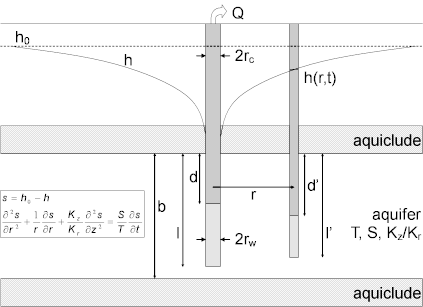Dougherty and Babu Solution for Step-Drawdown Tests in Confined Aquifers

Dougherty and Babu (1984) developed a mathematical solution for interpreting pumping tests in nonleaky confined aquifers. Their solution accounts for wellbore storage and wellbore skin in a finite-diameter, partially penetrating well; hydraulic conductivity anisotropy was added to the solution by Moench (1988).
Assumptions
- aquifer has infinite areal extent
- aquifer is homogeneous, anisotropic and of uniform thickness
- pumping well is fully or partially penetrating
- flow to control well is horizontal when the control well is fully penetrating
- aquifer is nonleaky confined
- flow is unsteady
- water is released instantaneously from storage with decline of hydraulic head
Equations
The Dougherty and Babu pumping test solution includes drawdown components for aquifer loss, partial penetration loss and linear well loss due to wellbore skin. It is a straightforward matter to add nonlinear well loss to drawdown in the pumped well (Bear 1979):
where
- is aquifer thickness [L]
- is nonlinear well loss coefficient [TP/L3P-1]
- is the depth to the top of pumping well screen [L]
- is radial (horizontal) hydraulic conductivity [L/T]
- is vertical hydraulic conductivity [L/T]
- is modified Bessel function of second kind, order
- is the depth to the bottom of pumping well screen [L]
- is the Laplace transform variable
- is pumping rate [L³/T]
- is radial distance from pumping well to observation well [L]
- is casing radius [L]
- is well radius [L]
- is drawdown in pumped well [L]
- is storativity [dimensionless]
- is wellbore skin factor [dimensionless]
- is elapsed time since start of pumping [T]
- is transmissivity [L²/T]
- is the inverse Laplace transform operator
The exponent, , in the nonlinear well loss term, , is generally taken as 2 as originally proposed by Jacob (1947); however, Rorabaugh (1953) postulated that may range between 1.5 and 3.5.
AQTESOLV performs inverse Laplace transformation, , through the application of numerical inversion techniques.
Data Requirements
- pumping and observation well locations
- pumping rate(s)
- observation well measurements (time and displacement)
- casing radius and wellbore radius for pumping well(s)
- downhole equipment radius (optional)
- partial penetration depths
- saturated thickness
- hydraulic conductivity anisotropy ratio
Solution Options
- large-diameter pumping wells
- variable pumping rates
- multiple pumping wells
- multiple observation wells
- partially penetrating wells
- boundaries
Estimated Parameters
AQTESOLV provides visual and automatic methods for matching the Dougherty and Babu method to data from step-drawdown tests and recovery tests. The estimated aquifer properties are as follows:
- (transmissivity)
- (storativity)
- (hydraulic conductivity anisotropy ratio)
- (dimensionless wellbore skin factor)
- (well radius)
- (nominal casing radius)
- (nonlinear well loss coefficient)
- (nonlinear well loss exponent)
Curve Matching Tips
- Use radial flow plots to help diagnose wellbore storage.
- Match the Cooper and Jacob (1946) solution to late-time data to obtain preliminary estimates of aquifer properties.
- Match early-time data affected by wellbore storage by adjusting with parameter tweaking.
- If you estimate for the test well, the estimated value replaces the nominal casing radius and AQTESOLV still performs the correction for downhole equipment.
- Choose Match>Visual to perform visual curve matching using the procedure for type curve solutions.
- Use active type curves for more effective visual matching with variable-rate pumping tests.
- Select values of from the Family and Curve drop-down lists on the toolbar.
- Use parameter tweaking to perform visual curve matching and sensitivity analysis.
- Perform visual curve matching prior to automatic estimation to obtain reasonable starting values for the aquifer properties.
References
Dougherty, D.E and D.K. Babu, 1984. Flow to a partially penetrating well in a double-porosity reservoir, Water Resources Research, vol. 20, no. 8, pp. 1116-1122.
Moench, A.F., 1988. The response of partially penetrating wells to pumpage from double-porosity aquifers, Proceedings of the International Conference on Fluid Flow in Fractured Rocks, Atlanta, GA, May 16-18, 1988.
Jacob, C.E., 1947. Drawdown test to determine effective radius of artesian well, Trans. Amer. Soc. of Civil Engrs., vol. 112, paper 2321, pp. 1047-1064.
Ramey, H.J., 1982. Well-loss function and the skin effect: A review. In: Narasimhan, T.N. (ed.) Recent trends in hydrogeology, Geol. Soc. Am., special paper 189, pp. 265-271.
Rorabaugh, M.J., 1953. Graphical and theoretical analysis of step-drawdown test of artesian well, Proc. Amer. Soc. Civil Engrs., vol. 79, separate no. 362, 23 pp.